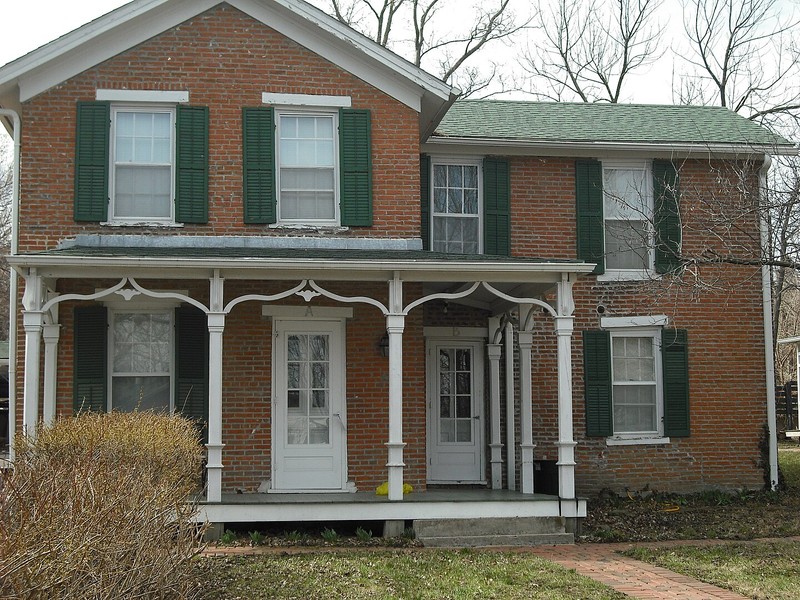Priestly House
Introduction
Text-to-speech Audio
One year after Quantill's Raid devastated Lawrence in 1863, John Bowles built this home on Kentucky Street, selecting a location near the University of Kansas that opened two years later in 1866. William Priestly, a captain during the U.S. Civil War, moved his family to Lawrence in 1871 and subsequently purchased the home where he and his wife raised numerous children who would later attend and graduate from the University of Kansas. The Priestly family owned the home for more than a century, finally selling it in 1986. The home survives as a reminder of the town's rebirth after the 1863 Civil War raid and the genesis of the university.
Images
Priestly House, built in 1864

Backstory and Context
Text-to-speech Audio
The 1854 Kansas-Nebraska Act established the territorial boundaries of Kansas and Nebraska, stipulating that its territorial residents would decide by popular vote whether their state would permit the extension of slavery into the new territory. Understanding that Kansas would become a state long before Nebraska, the 1854 law meant that Kansas Territory would play a decisive role in the leading question of the day- whether slavery would extend into the American West. Several members of the pro-abolitionist New England Emigrant Aid Company from Massachusetts established Lawrence a year later, and the community became home to committed abolitionists as well as a larger group who simply opposed the extension of slavery. Lawrence's Free State reputation led to numerous bloody clashes with pro-slavery groups that preceded the Civil War. Violence continued during the war, culminating in one of the most deadly terrorist attacks on American soil on August 21, 1863, when pro-Confederate bushwhacker William Quantrill led his guerrilla-style troops into Lawrence. Quantrill and his raiders killed more than 150 men and boys, burned half the residential homes, and destroyed more than seventy-five commercial buildings in the business district.
Lawrence was Kansas' second leading commercial center before the war, and residents immediately began the process of reconstruction. By the end of the war, the city was thriving once again and a branch of the transcontinental railroad arrived in the north part of town, followed by another train on the east side of Lawrence in 1867. During the 1860s and early 1870s, Lawrence matured into a regional railroad hub. The railroad transported American migrants and immigrants through Lawrence, with many deciding to stay in Lawrence rather than continue westward. The railroads and subsequent population boom boosted the town's economic growth, leading to a boom period from roughly 1864 to 1874, known as the "City Building" period.
The City Building era also included the formation of the University of Kansas (KU), which further helped Lawrence's post-raid expansion. The legislature organized KU in 1864, and it opened two years later. With news about Lawrence becoming the home to KU, developers began building homes as a speculative endeavor as early as 1864; the Priestly House (circa 1864) likely arose as part of that real estate initiative.
William Priestly, Captain of the 93rd Ohio Volunteers during the Civil War, moved his family from Baldwin, Kansas, to Lawrence in 1872, and he purchased the now-historic home on April 23, 1872, from its second owner, Dennis S. Gibbs. Priestly moved to Lawrence so his children could attend KU (at least three of his children enrolled). Indeed, Priestly's daughter, Carrie Priestly Yates, stood as one of the first women to graduate from the University of Kansas.
Shortly after the Priestly family arrived, the "Panic of 1873" and the ensuing national economic recession hit Lawrence and the county hard, leading to immense government debt, failing banks, and a population decline; the City Building period ended. The town suffered further in 1874 when a drought and grasshopper infestation devastated the farms of Douglas County. Nearly 1,000 residents left Lawrence during the mid- and late-1870s. Nevertheless, the Priestly family stayed, and they saw the town's economy slowly rebound by the 1880s despite Kansas City emerging as the area's railroad hub and largest urban center. Members of the Priestly family owned and resided in the dwelling for 1114 years, finally selling it in 1986.
The home avoided demolition by the 1980s when the Lawrence Preservation Alliance purchased the house. The alliance also secured its historic value when it sold the property in 1987 to William Haw, who agreed to a contract that stipulated he refrain from making improvements or alterations without approval. Thus, the home survives as a lasting example of the City Building period, the birth of KU, and the town's ability to rise from the ashes after Quantrill and his men burned much of Lawrence during the Civil War.
Sources
Epps, Kristen. "The Missouri-Kansas Conflict,1855-1865: Quantrill's Raid on Lawrence." Civil War on the Western Border. civilwaronthewesternborder.org. Accessed February 8, 2024. https://civilwaronthewesternborder.org/encyclopedia/quantrills-raid-lawrence#:~:text=William%20Quantrill's%20raid%20on%20the,and%20190%20men%20and%20boys.
Gray, Barbara Allison. "Registration Form: Priestly House." National Register of Historic Places. nps.gov. 1987. https://npgallery.nps.gov/GetAsset/f93697bb-ad7d-4f8d-9e7f-592e97fdc093/.
Kansas Historical Society. "University of Kansas." Kansaspedia. kshs.org. July 2014. https://www.kshs.org/kansapedia/university-of-kansas/18617.
Parsons, Gail Pat. "Puerperal fever, anticontagionists, and miasmatic infection, 1840-1860: toward a new history of puerperal fever in antebellum America." Journal of the History of Medicine and Allied Sciences 52, no. 4 (1997): 424-452.
Stanley, Matthew E. "Quantrill, William Clarke." Civil War on the Western Border: The Missouri-Kansas Conflict, 1854-1865. The Kansas City Public Library. Accessed February 8, 2024. https://civilwaronthewesternborder.org/encyclopedia/quantrill-william-clarke.
By Bhall87 at English Wikipedia, CC BY-SA 3.0, https://commons.wikimedia.org/w/index.php?curid=17983887
